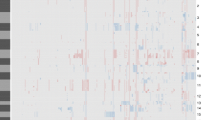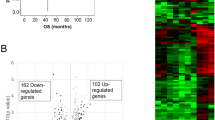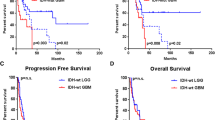Abstract
Gliomatosis cerebri (GC) are extensively infiltrative glial tumors classified as astrocytic tumors in the current World Health Organization (WHO) classification scheme. In investigating the tumorigenesis of GC, we reviewed 28 cases of GC immunohistochemically and carried out array-based comparative genomic hybridization (CGH) in ten of those cases. In histological and immunohistochemical review, 18 cases (64%) were of astrocytic lineage, three (11%) were of oligodendroglial lineage, and seven (25%) were of uncommitted lineage. In the array-based CGH, 52 clones were frequently lost on 6p, 9p, and 9q in more than six cases, and six clones were frequently gained on 1p, 6q, 10q, and 21q in more than three cases. Some gained or lost genetic loci differed significantly between the histologically high-grade and low-grade GC (P < 0.05), but unsupervised hierarchical clustering failed to produce evidence of any clinical significance. These altered genetic foci are not known to be involved in the development of conventional glial tumors, including astrocytic tumors. In conclusion, despite the dominant astrocytic differentiation of GC histologically, novel genomic aberrations found in our GC cases were different from those of astrocytic tumors.





Similar content being viewed by others
References
Braeuninger S, Schneider-Stock R, Kirches E, Powers JM, Korones DN, Mawrin C (2007) Evaluation of molecular genetic alterations associated with tumor progression in a case of gliomatosis cerebri. J Neurooncol 82:23–27. doi:10.1007/s11060-006-9245-7
Hecht BK, Turc-Carel C, Chatel M, Lonjon M, Roche JL, Gioanni J et al (1995) Chromosomes in gliomatosis cerebri. Genes Chromosomes Cancer 14:149–153. doi:10.1002/gcc.2870140210
Herrlinger U, Felsberg J, Kuker W, Bornemann A, Plasswilm L, Knobbe CB et al (2002) Gliomatosis cerebri: molecular pathology and clinical course. Ann Neurol 52:390–399. doi:10.1002/ana.10297
Johnson NA, Hamoudi RA, Ichimura K, Liu L, Pearson DM, Collins VP et al (2006) Application of array CGH on archival formalin-fixed paraffin-embedded tissues including small numbers of microdissected cells. Lab Invest 86:968–978. doi:10.1038/labinvest.3700441
Kattar MM, Kupsky WJ, Shimoyama RK, Vo TD, Olson MW, Bargar GR et al (1997) Clonal analysis of gliomas. Hum Pathol 28:1166–1179. doi:10.1016/S0046-8177(97)90255-0
Kim DG, Yang HJ, Park IA, Chi JG, Jung HW, Han DH et al (1998) Gliomatosis cerebri: clinical features, treatment, and prognosis. Acta Neurochir (Wien) 140:755–762. doi:10.1007/s007010050176
Kirches E, Mawrin C, Schneider-Stock R, Krause G, Scherlach C, Dietzmann K (2003) Mitochondrial DNA as a clonal tumor cell marker: gliomatosis cerebri. J Neurooncol 61:1–5. doi:10.1023/A:1021296212233
Kleihues PCW (ed) (2000) WHO classification, tumours of the nervous system. IARC Press, Lyon, France
Kros JM, Zheng P, Dinjens WN, Alers JC (2002) Genetic aberrations in gliomatosis cerebri support monoclonal tumorigenesis. J Neuropathol Exp Neurol 61:806–814
Lingjaerde OC, Baumbusch LO, Liestol K, Glad IK, Borresen-Dale AL (2005) CGH-explorer: a program for analysis of array-CGH data. Bioinformatics 21:821–822. doi:10.1093/bioinformatics/bti113
Luis DNOH, Wiestler OD, Cavenee WK (eds) (2007) WHO classification of tumours of the central nervous system. IARC Press, Lyon, France
Mawrin C (2005) Molecular genetic alterations in gliomatosis cerebri: what can we learn about the origin and course of the disease? Acta Neuropathol 110:527–536. doi:10.1007/s00401-005-1083-8
Mawrin C, Kirches E, Schneider-Stock R, Scherlach C, Vorwerk C, Von Deimling A et al (2003) Analysis of TP53 and PTEN in gliomatosis cerebri. Acta Neuropathol 105:529–536
Mawrin C, Lins H, Kirches E, Schildhaus HU, Scherlach C, Kanakis D et al (2003) Distribution of p53 alterations in a case of gliomatosis cerebri. Hum Pathol 34:102–106. doi:10.1053/hupa.2003.1
Mawrin C, Kirches E, Schneider-Stock R, Boltze C, Vorwerk CK, von Mawrin A et al (2005) Alterations of cell cycle regulators in gliomatosis cerebri. J Neurooncol 72:115–122. doi:10.1007/s11060-004-2061-z
Oostlander AE, Meijer GA, Ylstra B (2004) Microarray-based comparative genomic hybridization and its applications in human genetics. Clin Genet 66:488–495. doi:10.1111/j.1399-0004.2004.00322.x
Pinkel D, Albertson DG (2005) Array comparative genomic hybridization and its applications in cancer. Nat Genet 37(Suppl):S11–S17. doi:10.1038/ng1569
Pinkel D, Straume T, Gray JW (1986) Cytogenetic analysis using quantitative, high-sensitivity, fluorescence hybridization. Proc Natl Acad Sci USA 83:2934–2938. doi:10.1073/pnas.83.9.2934
Pinkel D, Segraves R, Sudar D, Clark S, Poole I, Kowbel D et al (1998) High resolution analysis of DNA copy number variation using comparative genomic hybridization to microarrays. Nat Genet 20:207–211. doi:10.1038/2524
Scheinker MEJ (1943) Diffuse cerebral glioblastosis. J Neuropathol Exp Neurol 2:178–189. doi:10.1097/00005072-194304000-00007
Taillibert S, Chodkiewicz C, Laigle-Donadey F, Napolitano M, Cartalat-Carel S, Sanson M (2006) Gliomatosis cerebri: a review of 296 cases from the ANOCEF database and the literature. J Neurooncol 76:201–205. doi:10.1007/s11060-005-5263-0
Tancredi A, Mangiola A, Guiducci A, Peciarolo A, Ottaviano P (2000) Oligodendrocytic gliomatosis cerebri. Acta Neurochir (Wien) 142:469–472. doi:10.1007/s007010050459
Vates GE, Chang S, Lamborn KR, Prados M, Berger MS (2003) Gliomatosis cerebri: a review of 22 cases. Neurosurgery 53:261–271, discussion 271. doi:10.1227/01.NEU.0000073527.20655.E6
Yang YH, Dudoit S, Luu P, Lin DM, Peng V, Ngai J et al (2002) Normalization for cDNA microarray data: a robust composite method addressing single and multiple slide systematic variation. Nucleic Acids Res 30:e15. doi:10.1093/nar/30.4.e15
Acknowledgment
This work was supported by a grant (04-2007-058-0) from Seoul National University Hospital.
Author information
Authors and Affiliations
Corresponding author
Rights and permissions
About this article
Cite this article
Min, H.S., Kim, B. & Park, SH. Array-based comparative genomic hybridization and immunohistochemical studies in gliomatosis cerebri. J Neurooncol 90, 259–266 (2008). https://doi.org/10.1007/s11060-008-9665-7
Received:
Accepted:
Published:
Issue Date:
DOI: https://doi.org/10.1007/s11060-008-9665-7




